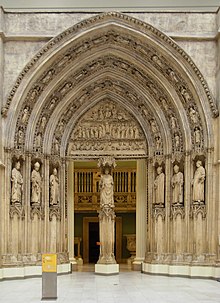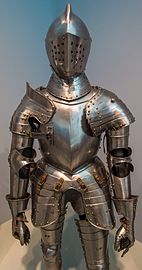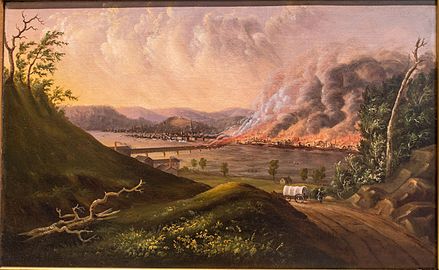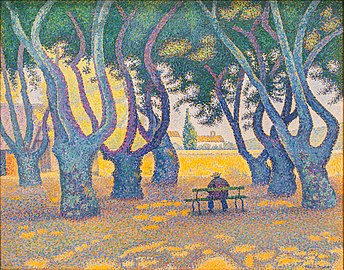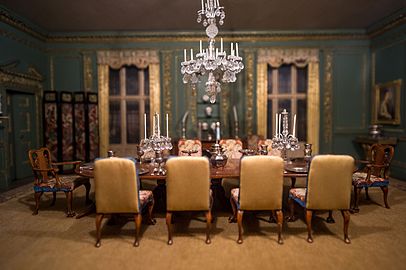
André Derain was a French artist, painter, sculptor and co-founder of Fauvism with Henri Matisse.

The National Gallery of Art is an art museum in Washington, D.C., United States, located on the National Mall, between 3rd and 9th Streets, at Constitution Avenue NW. Open to the public and free of charge, the museum was privately established in 1937 for the American people by a joint resolution of the United States Congress. Andrew W. Mellon donated a substantial art collection and funds for construction. The core collection includes major works of art donated by Paul Mellon, Ailsa Mellon Bruce, Lessing J. Rosenwald, Samuel Henry Kress, Rush Harrison Kress, Peter Arrell Browne Widener, Joseph E. Widener, and Chester Dale. The Gallery's collection of paintings, drawings, prints, photographs, sculpture, medals, and decorative arts traces the development of Western art from the Middle Ages to the present, including the only painting by Leonardo da Vinci in the Americas and the largest mobile created by Alexander Calder.
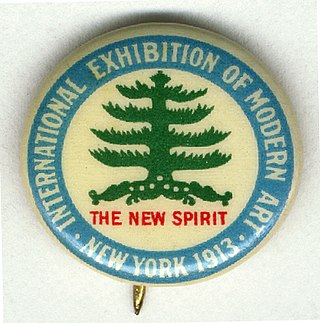
The 1913 Armory Show, also known as the International Exhibition of Modern Art, was organized by the Association of American Painters and Sculptors. It was the first large exhibition of modern art in America, as well as one of the many exhibitions that have been held in the vast spaces of U.S. National Guard armories.

Carnegie Museums of Pittsburgh is a nonprofit organization that operates four museums in Pittsburgh, Pennsylvania, United States. The organization is headquartered in the Carnegie Institute and Library complex in the Oakland neighborhood of Pittsburgh. The Carnegie Institute complex, which includes the original museum, recital hall, and library, was added to the National Register of Historic Places on March 30, 1979.
The Carnegie International is a North American exhibition of contemporary art from around the globe. It was first organized at the behest of industrialist and philanthropist Andrew Carnegie on November 5, 1896, in Pittsburgh. Carnegie established the International to educate and inspire the public as well as to promote international cooperation and understanding. He intended the International to provide a periodic sample of contemporary art from which Pittsburgh's Carnegie Museum of Art could enrich its permanent collection.

Paul Mellon was an American philanthropist and an owner/breeder of thoroughbred racehorses. He is one of only five people ever designated an "Exemplar of Racing" by the National Museum of Racing and Hall of Fame. He was co-heir to one of America's greatest business fortunes, derived from the Mellon Bank created by his grandfather Thomas Mellon, his father Andrew W. Mellon, and his father's brother Richard B. Mellon. In 1957, when Fortune prepared its first list of the wealthiest Americans, it estimated that Paul Mellon, his sister Ailsa Mellon-Bruce, and his cousins Sarah Mellon and Richard King Mellon, were all among the richest eight people in the United States, with fortunes of between US$400 and 700million each.
Sarah Cordelia Mellon Scaife was an American heiress, philanthropist, and Republican Party donor. Her legacy includes the Sarah Scaife Foundation.

Nancy Graves was an American sculptor, painter, printmaker, and sometime-filmmaker known for her focus on natural phenomena like camels or maps of the Moon. Her works are included in many public collections, including those of the National Gallery of Art, the Brooklyn Museum of Art, the Smithsonian American Art Museum, the National Gallery of Australia (Canberra), the Des Moines Art Center, Walker Art Center (Minneapolis), and the Museum of Fine Arts. When Graves was just 29, she was given a solo exhibition at the Whitney Museum of American Art. At the time she was the youngest artist, and fifth woman to achieve this honor.

Nathan Isaevich Altman Russian: Натан Исаевич Альтман, romanized: Natan Isayevich Altman; Ukrainian: Натан Ісайович Альтман; December 22 [O.S. December 10] 1889 – December 12, 1970) was a Russian avant-garde artist, Cubist painter, stage designer and book illustrator, who was born in Ukraine in the Russian Empire and worked in France and the Soviet Union.

Isa Genzken is a German artist who lives and works in Berlin. Her primary media are sculpture and installation, using a wide variety of materials, including concrete, plaster, wood and textile. She also works with photography, video, film and collage.

The San Diego Museum of Art is a fine arts museum located at 1450 El Prado in Balboa Park in San Diego, California that houses a broad collection with particular strength in Spanish art. The San Diego Museum of Art opened as The Fine Arts Gallery of San Diego on February 28, 1926, and changed its name to the San Diego Museum of Art in 1978. The official Balboa Park website calls the San Diego Museum of Art "the region's oldest and largest art museum". Nearly half a million people visit the museum each year.
Mel Bochner is an American conceptual artist. Bochner received his BFA in 1962 and honorary Doctor of Fine Arts in 2005 from the School of Art at Carnegie Mellon University. He lives in New York City.

Elizabeth Nourse was a realist-style genre, portrait, and landscape painter born in Mt. Healthy, Ohio, in the Cincinnati area. She also worked in decorative painting and sculpture. Described by her contemporaries as "the first woman painter of America" and "the dean of American woman painters in France and one of the most eminent contemporary artists of her sex," Nourse was the first American woman to be voted into the Société Nationale des Beaux-Arts. She also had the honor of having one of her paintings purchased by the French government and included in the Luxembourg Museum's permanent collection. Nourse's style was described by Los Angeles critic Henry J. Seldis as a "forerunner of social realist painting." Some of Nourse's works are displayed at the Cincinnati Art Museum.

The Harris Museum is a Grade I-listed building in Preston, Lancashire, England. Founded by Edmund Harris in 1877, it is a local history and fine art museum.

The McNay Art Museum, founded in 1954 in San Antonio, is the first modern art museum in the U.S. state of Texas. The museum was created by Marion Koogler McNay's original bequest of most of her fortune, her important art collection and her 24-room Spanish Colonial Revival-style mansion that sits on 23 acres (9.3 ha) that are landscaped with fountains, broad lawns and a Japanese-inspired garden and fishpond.
Elaine A. King is a curator, critic, professor, and editor.

John Rogers Cox was an American painter from Terre Haute, Indiana. His style and subject matter align him with the Regionalist and Magic Realist landscape tradition.
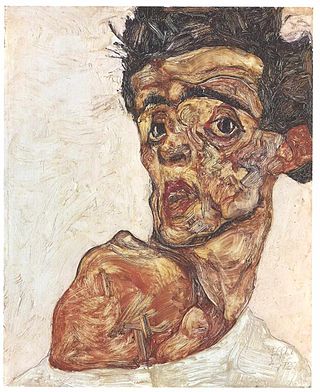
Facing the Modern: The Portrait in Vienna 1900 was an exhibition at the National Gallery, London, running from 9 October 2013 through to 12 January 2014.
Brett Yasko is an American graphic designer. He has designed books, gallery guides, catalogues and exhibitions for numerous artists and institutions.
T. F. Gustave Von Groschwitz was an American art administrator who served as director of the Carnegie Museum of Art and associate director of the University of Iowa Stanley Museum of Art.




